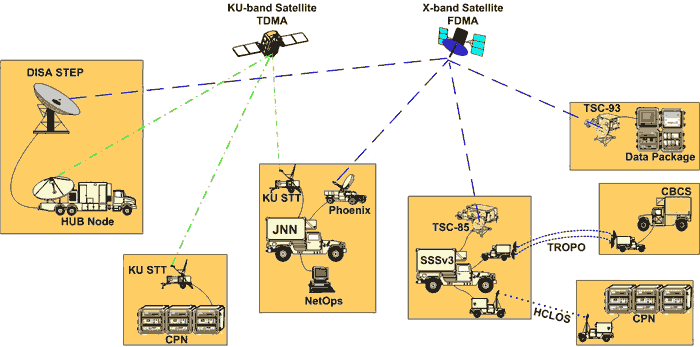Expeditionary Signal Battalion Concept

Integrated Theater Signal Battalion (ITSB) was created to bring together capabilities previously found in a number of separate theater-level signal organizations that support Army organizations at echelons above corps (EAC). The Expeditionary Signal Battalion (ESB) is a modified version of the ITSB, integrating previous equipment with improved capabilities and equipment while maintaining a viable support concept until Warfighter Information Network-Tactical (WIN-T) is realized.
Signal Flow and Network Systems
STEP Standardized Tactical Entry Point (STEP) provides deployed forces with connectivity from tactical locations to the Defense Information Systems Network (DISN) and the DoD Global Information Grid (GIG). This provides reach-back capability between mobile, forward deployed units and fixed garrison stations. STEP sites typically support Defense Switched Network (DSN), high bandwidth Secret Internet Protocol Router (SIPR), Non-Secure Internet Protocol Router (NIPR), Sensitive But Unclassified (SBU), Coalition Wide Area Network (CWAN), Video Tele-Conference (VTC), and Defense Red Switch Network (DRSN).
Hub Node: Currently, much of DoD relies on STEP sites that provide access only through Frequency Division Multiple Access (FDMA) satellite terminals and do not support Voice Over Internet Protocol (VOIP) services. However, the ESB network relies heavily on Time Division Multiple Access (TDMA) satellite terminals and VOIP services. The Tactical (THN) or Fixed Regional (FRHN) Hub Nodes provides a bridge between ESB's TDMA and VOIP networks and the STEP sites FDMA and Circuit Switching networks.
FDMA vs TDMA: The difference between access techniques lies in the method used to divide services on the network. With FDMA all circuits are transmitted at the same time, but are on different portions of the frequency band. In contrast TDMA circuits can be on the same frequency band, but the multiple circuits are interleaved by time.
Transmission Systems: The capabilities, signal flow, and planning considerations of each transmission source listed below are covered in TBU's Basic Network Nodal Management course.
KU STT: KU STT: The SATCOM Transportable Terminal allows a JNN and CPN to access the Hub Node via TDMA network. There are two different variants of the STT. The STT deployed with the JNN contains an FDMA and conditioned diphase modems that are not used by the CPN. (AN/TSC-167D: (V)1 TDMA/FDMA, (V)2 TDMA only)
Phoenix: The AN/TSC-156 is a transportable Tactical Satellite Communications Terminal (TACSAT), which operates in the Super High Frequency (SHF) Bands (C-, X-, Ka-, and Ku-), FDMA only, over commercial and military satellites. The Phoenix is backward compatible with legacy TSC-85/93 and provides access to strategic networks via STEP.
HCLOS: The AN/TRC-190D is a Line of Sight (LOS) radio transmission system which provides large transmissions “pipes” of up to 16Mbps. These “pipes” can be installed between ESB systems or between ESB and legacy systems. TRC-190(V)1 contains one radio set, while the TRC-190(V)3 contains three radio sets providing three simultaneous links.
TROPO: Although the Tropospheric Scatter Radio (TROPO) can operate in LOS mode, the main function is to provide Beyond Line Of Sight (BLOS) by bouncing the radio signal off the troposphere. The recently upgraded AN/TRC-170(V)3 provides ranges in excess of 100 miles and bandwidth of up to 16 Mbps. .
AN/TSC-85/93D: These terminals are compatible with the area common user systems Tri-Service Tactical Communications (TRI-TAC) and provide reach back capability from deployed forces to the supporting base or CONUS via the Standardized Tactical Entry Point (STEP). These systems have recently undergone Service Life Extension Program (SLEP) “D” model upgrades. They typically deploy in a hub-spoke satellite network configuration with the AN/TSC-85C as the hub and the AN/TSC-93C as a spoke, but operate only in X-band.
SSS(V)3/4: The AN/TTC-56(V)3 updated Single Shelter Switch (SSS) replaces obsolete data equipment with updated STEP compatible multiplexer, DSN, high bandwidth SIPR, NIPR, SBU, CWAN, VTC, DRSN and VoIP, housed in a single Lightweight Multipurpose Shelter (LMS) mounted on Expanded-capability Vehicle (ECV). The SSS(V)3/4 utilizes FDMA satellite connectivity.
JNN: The Joint Network Node (JNN) is a Joint-compatible communications package that allows the Warfighter to use advanced networking capabilities. JNN is comprised of commercial-off-the-shelf (COTS) equipment capable of connecting to DISN services and to legacy MSE-equipped units. The JNN is located at the Brigade element. In addition to providing network services for a Brigade headquarters, the JNN serves as a distribution point between the Hub Node and CPN. The JNN can utilize both TDMA and FDMA satellite connectivity and provides NIPR/SIPR/CWAN data, Red/Black voice, and VTC.
CPN: The Command Post Node (CPN) provides direct network access to users within a Battalion element. It utilizes KU STT satellite or HCLOS connectivity. It has permanent links to the Hub Node and JNN or SSS(V)3 and can establish on demand connections to other CPNs within the network. The CPN is housed in transit cases and provides NIPR, SIPR, VTC, and Red/Black Voice access. .
NetOps: Provides Brigade and Battalion staff the ability to plan, configure, monitor, troubleshoot/report/track the network as well as real-time and historical status of the battle command services that utilize the network.
Data Package: While transitioning all units to ESB systems the Brigade continues to maintain data packages (DP). These systems consist of transit case mounted COTS devices similar to the JNN and SSS(v)3/4. The DP is capable of providing the same services, but lacks the TDMA and VOIP capabilities of the ESB systems.
CBCS: Common Baseline Circuit Switches consist of legacy TRI-TAC systems such as Large Extension Node (LEN: AN/TTC-46), Node Center (NC: AN/TTC-47), or Small Extension Node (SEN: AN/TTC-48). The JNN connects to CBCS through the Vantage, while the SSS(V)3 adds a Switch Multiplexing Unit (SMU) and Compact Digital Switch (CDS), both TRI-TAC systems.